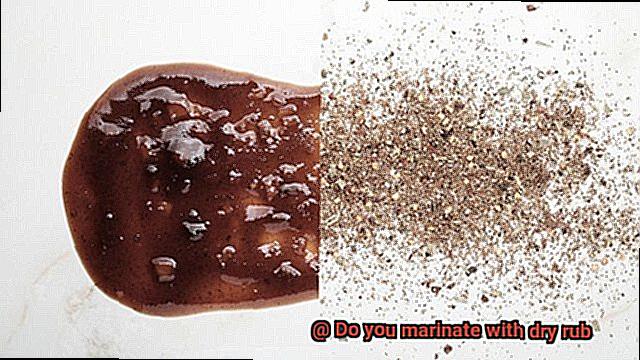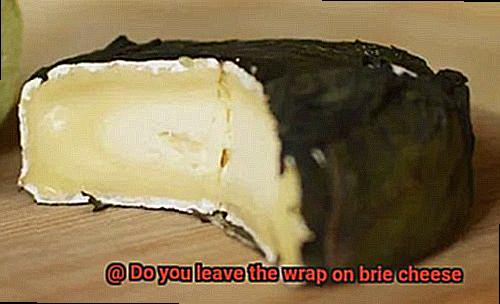If you’re a fan of finger-licking BBQ, then you know that the secret to mouth-watering meat lies in the marinade. But when it comes to marinating with dry rub, some grill masters swear by it while others stick to traditional liquid marinades. So, which one is better? The truth is, there’s no right or wrong answer – it all depends on your taste buds and the type of meat you’re cooking.
Dry rubs are a blend of aromatic spices and herbs that add a burst of flavor to your meat before cooking. They create a delicious crust on the outside while keeping the inside juicy and tender. On the other hand, marinades use acidic liquids like vinegar, citrus juice, or wine to break down proteins in the meat and infuse it with flavor.
In this blog post, we’ll explore the pros and cons of both methods so you can decide whether to marinate with dry rub or stick to traditional marinades. We’ll also share tips for creating the perfect dry rub blend, including must-have spices like paprika, cumin, and garlic powder. And if you prefer liquid marinades, we’ll guide you through choosing the best acid base for your meat and avoiding common mistakes like over-marinating.
Whether you’re an experienced pitmaster or just starting out on your grilling journey, this post will provide all the information you need to elevate your BBQ game. So fire up that grill and let’s settle this age-old debate once and for all: do you marinate with dry rub?
Contents
What is a Dry Rub?

A dry rub is a tantalizing blend of herbs, spices, and seasoning that is applied directly onto the surface of meat before cooking. Unlike liquid marinades, which can require hours of marinating time, dry rubs can be massaged into the meat right before cooking. This makes them an excellent choice for last-minute grilling or smoking sessions.
The beauty of dry rubs lies in their endless possibilities. Depending on personal preference and the type of meat being prepared, a dry rub can include anything from chili powder and paprika to cumin and garlic powder. These tantalizing combinations infuse meat with rich, complex flavor that is sure to satisfy even the most discerning palate.
One of the advantages of using a dry rub is that it creates a flavorful crust on the outside of the meat when cooked. This crust not only adds delicious flavor but also helps to seal in juices and keep meat moist. Dry rubs can be used on any type of cooking equipment, including grills, smokers, and ovens.
While dry rubs are most commonly used on meats like chicken, pork ribs, brisket, and steak, they can also be used on vegetables. Try using a dry rub on sweet potatoes or corn before grilling or roasting for a delicious side dish.
It’s important to note that not all meats are ideal for dry rubs. Tougher cuts like brisket or ribs benefit from longer marinating times and may require both a dry rub and liquid marinade for maximum flavor and tenderness. On the other hand, tender cuts like steaks or chicken breasts can be seasoned with just a dry rub before grilling.
Benefits of Using a Dry Rub
Look no further than dry rubs. These flavorful blends of herbs, spices, and seasonings offer a host of benefits when used on meats and veggies. As an expert in the field, let me walk you through the many benefits of using a dry rub.
First and foremost, dry rubs enhance the natural flavors of your food. With so many different combinations available, from sweet and smoky to spicy and bold, you can customize your dry rub to suit your tastes. And unlike marinades that require hours of marinating, dry rubs can be applied just before cooking, saving you precious time without sacrificing taste.
But that’s not all – dry rubs also create a crust on the surface of your food that adds texture and depth of flavor. This crust helps lock in moisture, keeping your meat or veggies juicy and tender. Plus, it looks pretty darn impressive too.
Not only do dry rubs taste fantastic and save you time, but they’re also a healthier option than many store-bought marinades. They’re generally lower in calories and fat, and contain fewer additives and preservatives.
To sum it up, using a dry rub is an easy and delicious way to add flavor to your grilled or smoked meats and veggies. Here are some specific benefits:
- Enhances natural flavors
- Saves time
- Creates a crust
- Healthier option
Types of Dry Rubs
If you’re a fan of grilling, smoking, or barbecuing your meats, then dry rubs are an essential ingredient that can elevate your dishes from good to great. Dry rubs are a blend of herbs and spices that are applied to meats before cooking, creating a delicious crust on the surface. With so many different types of dry rubs available, it can be challenging to decide which one to use. Here are five different types of dry rubs and their uses:
BBQ Dry Rub
This is perhaps the most popular type of dry rub, perfect for use on pork ribs or chicken. It typically contains a combination of brown sugar, paprika, chili powder, garlic powder, onion powder, salt, and pepper. The sweetness from the brown sugar balances out the smoky flavor from the paprika and chili powder.
Poultry Dry Rub
As its name suggests, this type of dry rub is perfect for chicken or turkey. A combination of herbs such as thyme, rosemary, sage, and oregano gives poultry a delicious aroma and flavor. Garlic powder, onion powder, salt, and pepper may also be added.
Spicy Dry Rub
If you like a little heat in your food, try a spicy dry rub. These types of dry rubs often contain cayenne pepper or chili powder to add heat to the dish. They can be used on any type of meat or vegetables.
Regional Dry Rubs
Some dry rubs are specific to certain regions or cuisines. For Louisiana cuisine lovers, the Cajun dry rub is a popular option that contains paprika, cayenne pepper, garlic powder, onion powder, thyme, and oregano. A Mediterranean dry rub may contain dried basil, oregano, thyme, rosemary, garlic powder, onion powder, salt and pepper.
Specialty Dry Rubs
For those looking for something outside the box, specialty dry rubs like coffee or cocoa-based rubs can add unique flavors to meats. These rubs create more complex dishes and add excitement to meals.
How to Apply a Dry Rub
Are you tired of serving up the same old bland meats at your barbecues? Do you want to take your grilling game to the next level? The secret to adding flavor and texture to your meats is applying a dry rub. Here are five easy steps to follow when applying a dry rub to your next grilling or barbecue session.
Choose Your Meat
The first step in applying a dry rub is selecting your preferred meat. Pork ribs, chicken wings, beef brisket, and pork shoulder are all popular options. Make sure the meat is at room temperature before applying the rub. This allows the flavors to penetrate the meat better.
Prepare Your Dry Rub
Next, prepare your dry rub according to your recipe or preference. Whether it’s a spicy rub or a sweeter mixture, ensure that the ingredients are well incorporated. Once you have your dry rub ready, generously apply it to the meat. Use your hands to massage the rub into the meat, making sure it’s evenly coated.
Amount of Dry Rub
It’s important to note that the amount of dry rub you use depends on the size of the meat. For larger cuts of meat like brisket or pork shoulder, you’ll need more dry rub than you would for smaller cuts like chicken wings or pork ribs. Ensure that every inch of the meat is covered with the rub.
Let It Sit
After applying the dry rub, let it sit for at least 30 minutes before cooking. You can also let it sit overnight in the fridge for even more flavor. This allows time for the flavors to penetrate and infuse into the meat.
Experiment with Making Your Own Dry Rubs
Lastly, don’t be afraid to experiment with making your own dry rubs. Start with a base of kosher salt and brown sugar, and add in your favorite spices like smoked paprika, cumin, or chili powder. The possibilities are endless, and you may just discover your new go-to dry rub recipe.
Meats That Are Ideal for Dry Rubs
Look no further than the power of dry rubs to add a burst of flavor to your meats. However, not all meats are created equal when it comes to using dry rubs. Let’s explore which meats are ideal candidates for this technique.
First up is pork. This versatile meat is perfect for dry rubs since it pairs well with a wide variety of spices. Whether you prefer paprika, chili powder, garlic powder, or cumin, these bold flavors can add a delicious kick to your next pork dish.
If you’re a beef lover, you’re in luck because beef holds up well against bold and robust spices. Black pepper, thyme, rosemary, and coriander are all popular choices that can elevate your beef dishes to new heights.
Another great option for dry rubs is chicken. As a lean meat, chicken can benefit from the added flavor of spices. Oregano, basil, garlic powder, and onion powder are just a few popular choices that can give your chicken dish an extra boost of flavor.
But what about fish? While not all types of fish are ideal for dry rubs, firmer fish like salmon or swordfish can handle bold flavors like cumin or smoked paprika. For more delicate fish like tilapia or cod, opt for lighter seasoning like lemon pepper or dill.
Meats That Require Both Liquid Marinade and Dry Rubs
Transform your meat dishes into something truly extraordinary with the dynamic duo of liquid marinades and dry rubs. These two techniques work together to infuse your chosen meat with mouthwatering flavors while simultaneously tenderizing it to perfection.
Pork shoulder, or Boston butt, is a prime example of a cut of meat that requires both a liquid marinade and dry rub. When used for pulled pork, the long cooking time can leave it tough and dry. However, a liquid marinade and dry rub work in tandem to break down the fibers and create a delicious bark on the outside of the pork.
Beef brisket is another meat that benefits from this magical combo. This tough cut of meat requires low and slow cooking to achieve its full potential. A liquid marinade helps to add moisture and tenderness to the meat, while the dry rub creates a flavorful outer crust.
Chicken is another fantastic candidate for this duo. A liquid marinade can add both moisture and flavor to chicken breasts, while a dry rub adds a delightful crispy texture when grilled or roasted.
It’s important to keep in mind that not all meats require both techniques. It’s best to experiment with various cuts of meat and flavor combinations to find what works best for you. However, meats that are tougher and require longer cooking times are excellent candidates for this dynamic duo.
Tips for Applying the Perfect Dry Rub
Look no further than the perfect dry rub. A combination of herbs, spices, and seasonings, a dry rub adds depth and complexity to your grilled or smoked meats. But how do you achieve the perfect balance of flavor? Here are five key steps to follow:
Step 1: Dry Your Meat.
Moisture is the enemy of a good dry rub. Before you apply the mixture, make sure your meat is completely dry. Use a paper towel to pat it down and remove any excess moisture. This will help the rub adhere better to the meat, ensuring an even coating.
Step 2: Apply the Rub Generously.
Don’t be stingy when it comes to applying the dry rub. Use plenty of it and make sure to massage it into the meat’s surface evenly. A good rule of thumb is to use one tablespoon of rub per pound of meat. The more rub you use, the more intense the flavor will be.
Step 3: Let It Sit.
After applying the dry rub, let your meat sit for at least 30 minutes, or up to overnight in the fridge. This allows time for the flavors to fully penetrate the meat. The longer it sits, the richer and more complex the flavor will be.
Step 4: Cook at a Lower Temperature.
When grilling or smoking meat with a dry rub, it’s important to cook at a lower temperature for longer periods. This allows the meat to cook slowly and evenly without burning the sugar in some of the seasoning. Aim for a temperature between 225-275°F and cook until your desired doneness is achieved.
Step 5: Customize to Your Taste.
Dry rubs can be customized based on your personal taste preferences. Experiment with different spice combinations and adjust the amount of salt and sugar to create a flavor profile that suits your taste buds. Don’t be afraid to get creative and try new things.
A-OZ66DQ2DM” >
Conclusion
In conclusion, the question of whether to marinate with dry rub or traditional liquid marinades is a matter of personal preference and the type of meat being cooked. Dry rubs offer a tantalizing blend of aromatic spices and herbs that create a mouthwatering crust on the outside while keeping the inside juicy and tender. Meanwhile, marinades use acidic liquids to infuse flavor into the meat.
The benefits of using dry rubs are numerous. They enhance natural flavors, save time, create a delicious crust, and are often a healthier option than store-bought marinades. With endless possibilities for customization, dry rubs can be used on any type of cooking equipment and even on vegetables.
When applying a dry rub, it’s important to choose the right meat and prepare the seasoning according to your recipe or preference. Applying the dry rub generously and evenly onto the meat is crucial for maximum flavor infusion. It’s also recommended to let it sit for at least 30 minutes before cooking to allow the flavors to fully permeate.
For certain meats like pork shoulder or beef brisket, using both liquid marinade and dry rub can result in maximum flavor and tenderness. Ultimately, choosing whether to marinate with dry rub or traditional liquid marinades comes down to personal taste preferences.
In summary, adding a dry rub is an effortless way to elevate your BBQ game and impress your guests with delectable finger-licking dishes.






